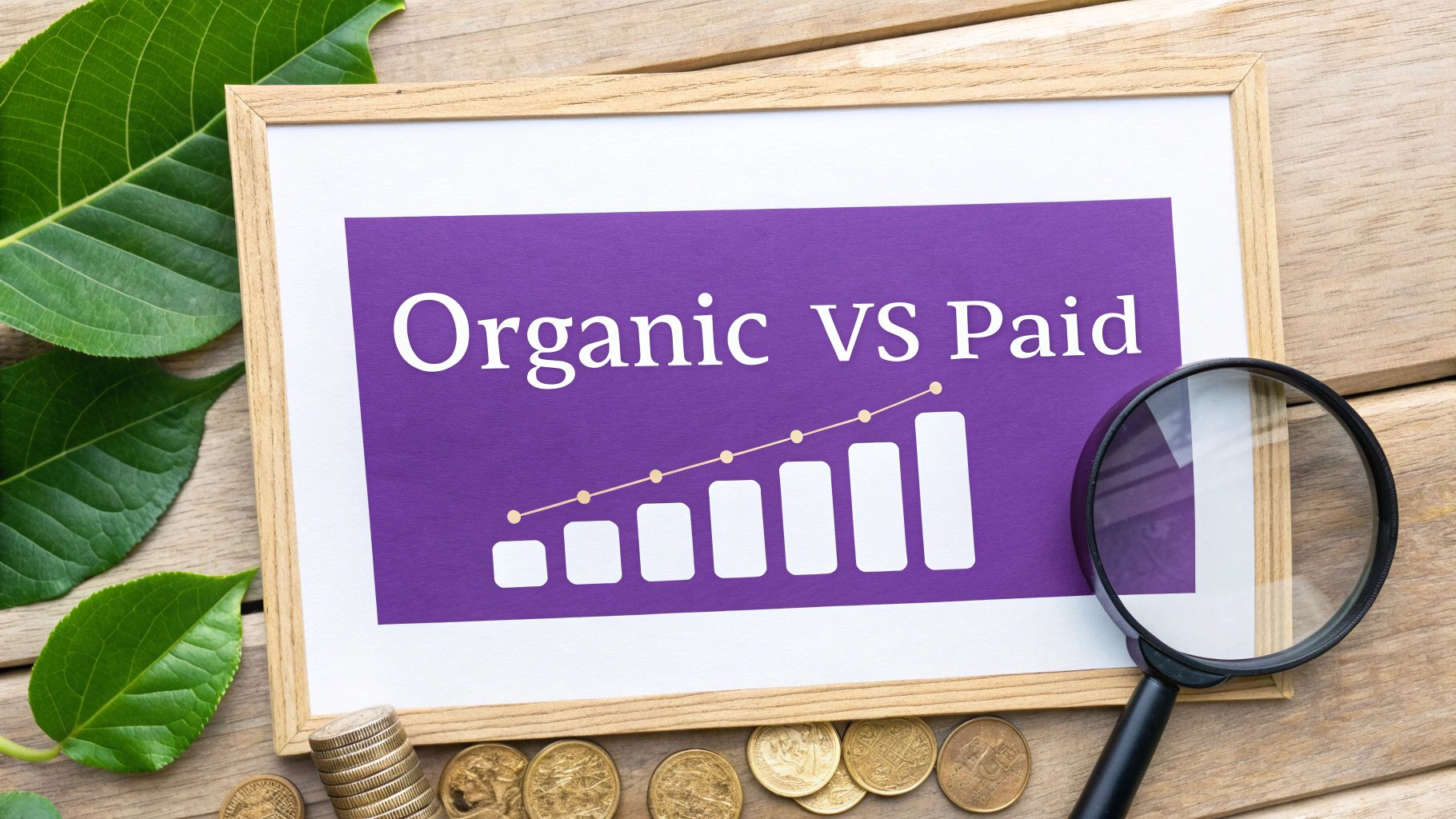Organic Search vs Paid Search A Complete Guide
Let's get one thing straight: the difference between organic and paid search isn't just a technicality—it's a fundamental choice between two totally different growth philosophies.
Think of it like this: Organic search (SEO) is like building a house. It takes time, effort, and a solid foundation, but once it's built, it provides lasting value and shelter. On the other hand, paid search (PPC) is like renting a billboard on the busiest highway in town. It gets you immediate, high-impact visibility, but the moment you stop paying, your ad comes down.
One is about earning authority for the long haul. The other is about buying speed and precision for right now.
What Are Organic Search and Paid Search?
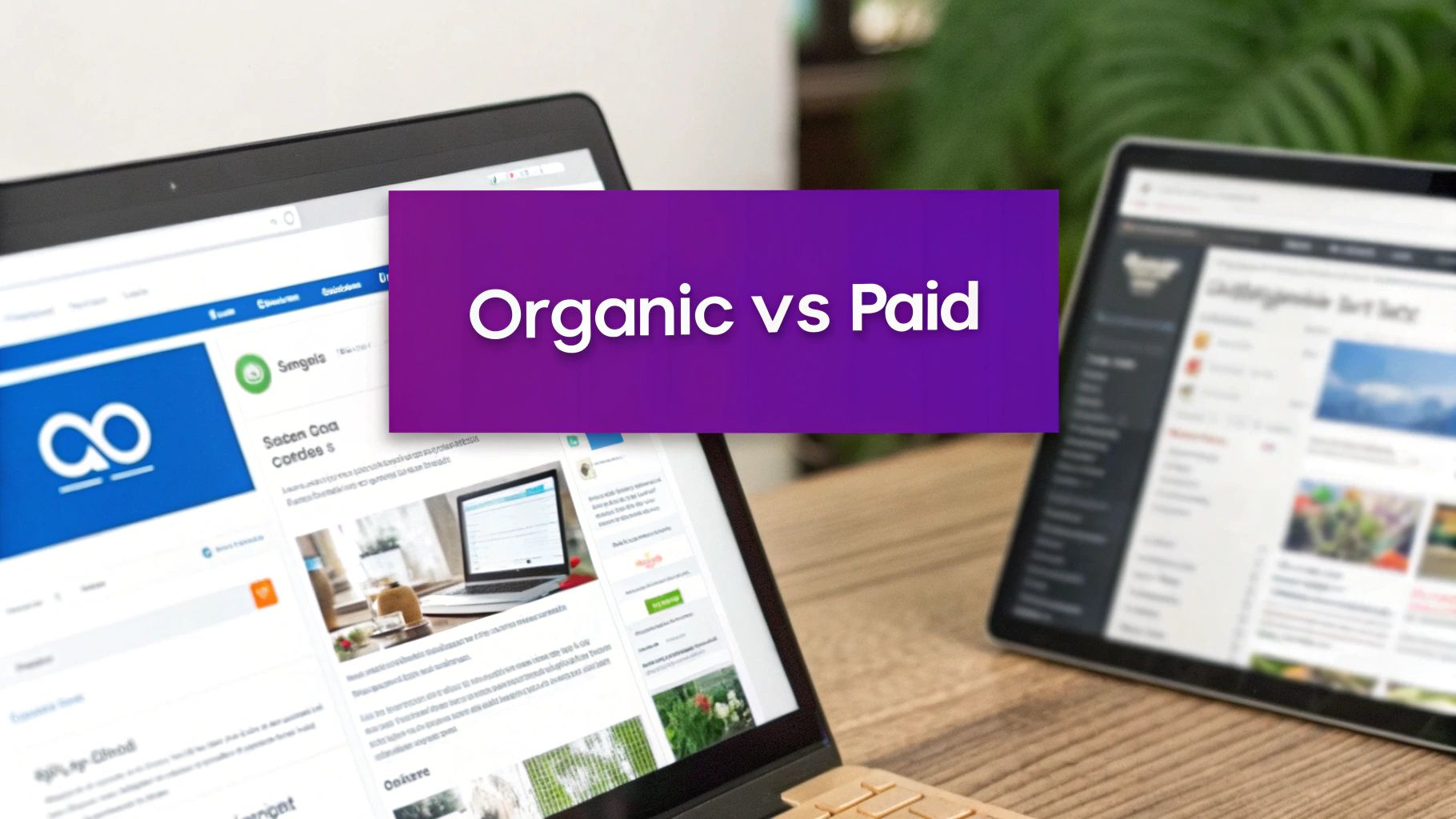
Before you can pick a side—or better yet, figure out how to use both—you need to get what makes each one tick. They both get you on Google, sure, but they operate on completely different principles.
The Foundation of Organic Search: SEO
Organic search is all about earning your spot on the search engine results page (SERP) without paying for clicks. The engine that drives this is Search Engine Optimization (SEO), which is the art and science of making your website irresistible to search engines like Google.
You do this by creating genuinely helpful content, making sure your site is technically sound, and building up its reputation across the web. If you want to go deeper, check out this a comprehensive guide to what SEO is and how it works. The goal is simple: convince Google that your page is the absolute best answer for what someone is searching for.
Key Takeaway: Organic search is about building a digital asset. The traffic you get is a direct result of the value and authority you've built, not a fee you pay to Google.
And it’s a massive driver of traffic. Most studies show that organic search is responsible for 53% to 68% of all trackable website traffic, making it the bedrock of sustainable, long-term visibility.
The Mechanics of Paid Search: PPC
Paid search, most often called Pay-Per-Click (PPC), is the fast track. Instead of earning your rank, you buy it.
Using platforms like Google Ads, you bid on the keywords you want to show up for. When someone searches for one of those terms, your ad appears at the very top of the page, usually with a little "Sponsored" tag.
The beauty of PPC is its speed and control. You can launch a campaign and start seeing traffic in hours, not months. And you only pay when someone actually clicks your ad, making it a highly measurable way to drive immediate action.
Core Differences At a Glance
To cut through the noise, here’s a quick side-by-side that lays out the core DNA of each channel.
| Cost Model | No charge per click (investment in time & resources) | Pay-per-click (direct ad spend) |
|---|---|---|
| Placement | Earned rankings based on relevance and authority | Top spots based on bid and ad quality |
| Time to Results | Gradual, long-term (months) | Immediate (hours or days) |
| Sustainability | Lasting value; traffic keeps coming after you stop | Traffic stops the second you turn off the ads |
| Primary Goal | Build authority, trust, and sustainable traffic | Drive immediate conversions and targeted traffic |
As you can see, they’re two sides of the same coin, each with a distinct role to play. One isn't universally "better"—it's about which one is better for your specific goals right now.
The Money Talk: Comparing Investment Models and Long-Term ROI
When you line up organic and paid search, it’s tempting to slap a “free” sticker on SEO and call it a day. That’s a huge mistake. Both demand serious investment—they just run on completely different financial playbooks. Understanding their cost structures and how they deliver returns over time is the key to spending your marketing budget wisely.
Paid search is a direct, pay-to-play model. You put money into ad spend and management, and you get a firehose of visibility almost instantly. It’s purely transactional: you pay, you get traffic.
The second you turn off the tap, the traffic vanishes. This makes paid search feel a lot like renting your spot at the top of Google instead of owning it.
The Upfront Costs of Paid Search
With paid search, the bills are tangible and show up on day one. Your main expenses are:
- Ad Spend: The cash you hand directly to platforms like Google Ads for every click or impression.
- Management Fees: What you pay an agency or a specialist to build, run, and fine-tune your campaigns so you don't burn money.
- Creative Costs: The investment needed to write killer ad copy and build landing pages that actually convert visitors.
This direct-cost model gives you incredible control, but it also means the expenses never really stop. The average Cost Per Click (CPC) hovers around $2.69, but that number can be seriously misleading. If you’re in a cutthroat industry like legal services, you might be paying over $6.75 a click. For certain finance keywords? You could see costs soar past $50.
The entire ROI of paid search hinges on one thing: your budget. Your results are directly chained to what you spend. If you double your budget, you might just double your traffic. But if you pause it, your traffic flatlines—instantly.
This is where metrics like Return on Ad Spend (ROAS) become your north star. It tells you the raw revenue you’re generating for every single dollar you put into advertising. If you want to get this right, you have to know how to calculate Return on Ad Spend.
Organic Search: Building an Asset That Pays You Back
Organic search, on the other hand, is all about building a long-term asset. The costs here are less about direct payments and more about "sweat equity" and smart resource allocation. You're investing in creating a durable marketing machine that will pay you back for years to come.
Your key investments in SEO look more like this:
- Content Creation: The time and money poured into creating genuinely helpful blog posts, guides, and pages that people are actually searching for.
- Technical SEO: The resources needed to make sure your website is fast, secure, and easy for search engines to understand.
- Authority Building: The grind of earning backlinks and establishing your brand as the go-to expert in your space.
Unlike paid search, the return on your organic effort compounds. That article you publish today might take months to climb the rankings, but once it hits page one, it can drive traffic and leads for years with little to no extra cost. This creates a sustainable growth engine that actually lowers your customer acquisition cost over time as your initial investment keeps appreciating in value.
Speed, Control, and Targeting: Where the Real Fight Is Won
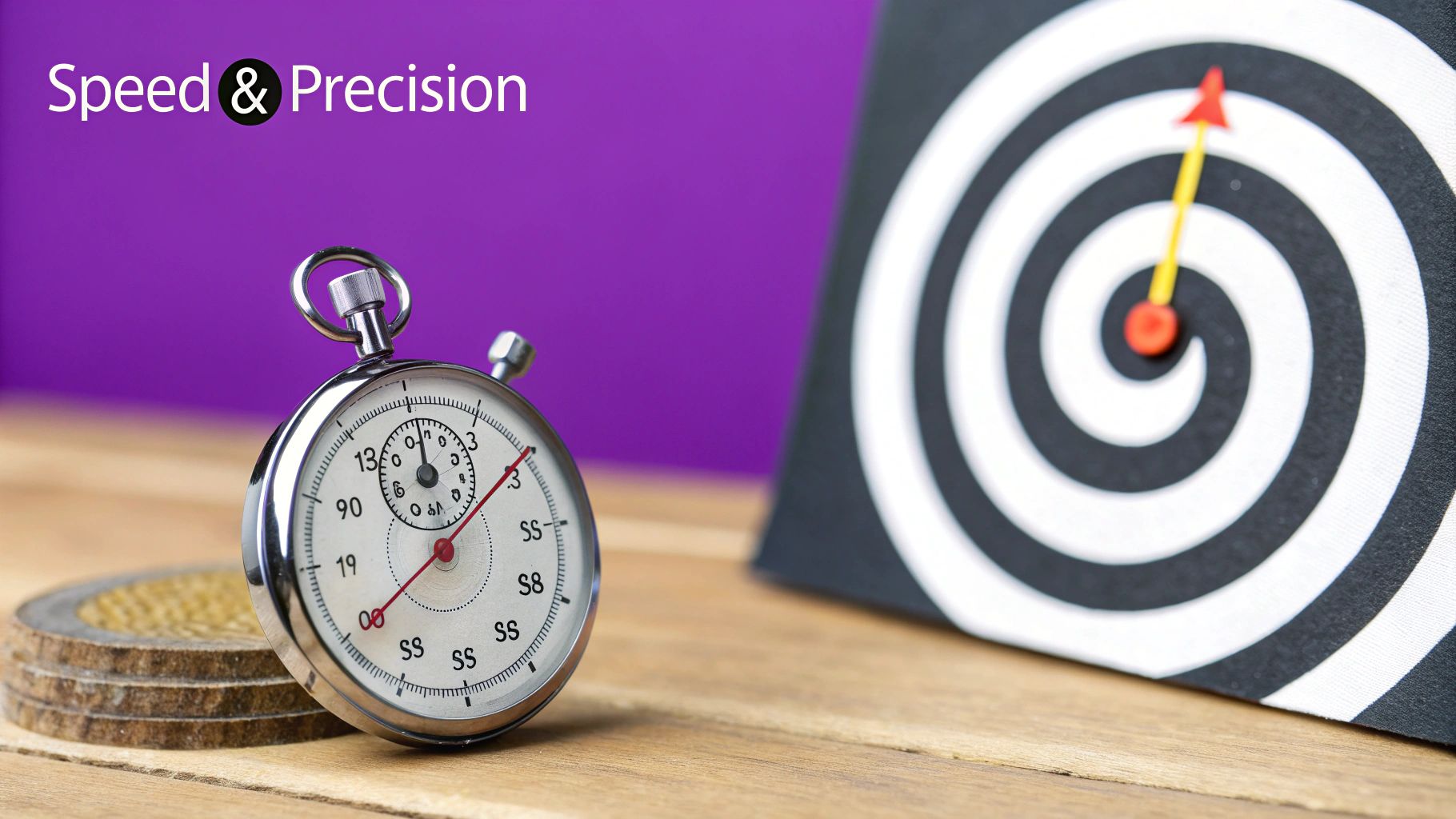
If there’s one place where organic and paid search feel like they’re from different planets, it’s here. Paid search is all about speed and precision—it’s the digital equivalent of flipping a switch and watching the lights come on. You can launch a campaign in the morning and see it at the top of Google by lunchtime.
That speed comes with an incredible amount of control. You’re in the driver’s seat for almost everything: the exact ad copy people see, the landing page they hit, how much you spend per day, and even what time of day your ads run.
Paid search works on your schedule, not Google’s. It lets you start, stop, pause, or completely change direction in real-time. This makes it a no-brainer for time-sensitive promotions, product launches, or A/B testing your messaging.
But the real magic of paid search lies in its hyper-specific audience targeting.
Precision Targeting: Paid Search’s Superpower
Paid search platforms let you get ridiculously specific about who you want to reach. You’re not just throwing ads into the void; you’re hand-delivering them to your ideal customer.
The targeting options are deep and powerful:
- Demographic Targeting: Zero in on users by age, gender, parental status, or even household income.
- Geographic Targeting: Show your ads to people in a specific country, city, zip code, or within a one-mile radius of your storefront.
- Remarketing: This is a big one. You can get back in front of people who visited your site but didn’t convert. Our guide on what is retargeting advertising breaks down how effective this tactic is.
- Device Targeting: Want to reach mobile users on the go? Or desktop users during work hours? You can do that.
The Slow Burn: Organic Search and User Intent
Organic search is the polar opposite. It’s a long game where you have influence, but not direct control. You can’t just decide you want to rank #1 tomorrow; you have to earn that spot over months of consistent, high-quality work. The final say always belongs to the search engine algorithms.
But what organic search lacks in speed, it makes up for with its own powerful form of targeting: user intent.
When someone finds your site organically, it’s because you had the best answer to their specific question. That alignment between what they’re looking for and what you offer creates a level of trust and engagement that’s tough to replicate.
And the scale of this opportunity is just staggering. Google now handles over 8.5 billion searches every single day. Every one of those searches is a real person actively looking for something, which just goes to show the massive potential for both paid and organic to connect with people who are ready to act.
Evaluating Brand Credibility and User Trust
The tug-of-war between organic and paid search goes way beyond budgets and timelines. It gets right to the heart of a much more human question: how do people feel about your brand when they find you? The psychological wiring behind each channel is completely different, shaping a user's trust from the very first click.
Think about it. When your site shows up at the top of the organic results, it feels like an endorsement from Google itself. It sends a powerful signal of authority and relevance, suggesting you’ve earned that spot through sheer merit, not by opening your wallet. That builds a foundation of trust before a user even lands on your page.
This infographic paints a clear picture of how user trust and engagement diverge, depending on whether they click on an organic result or a paid ad.
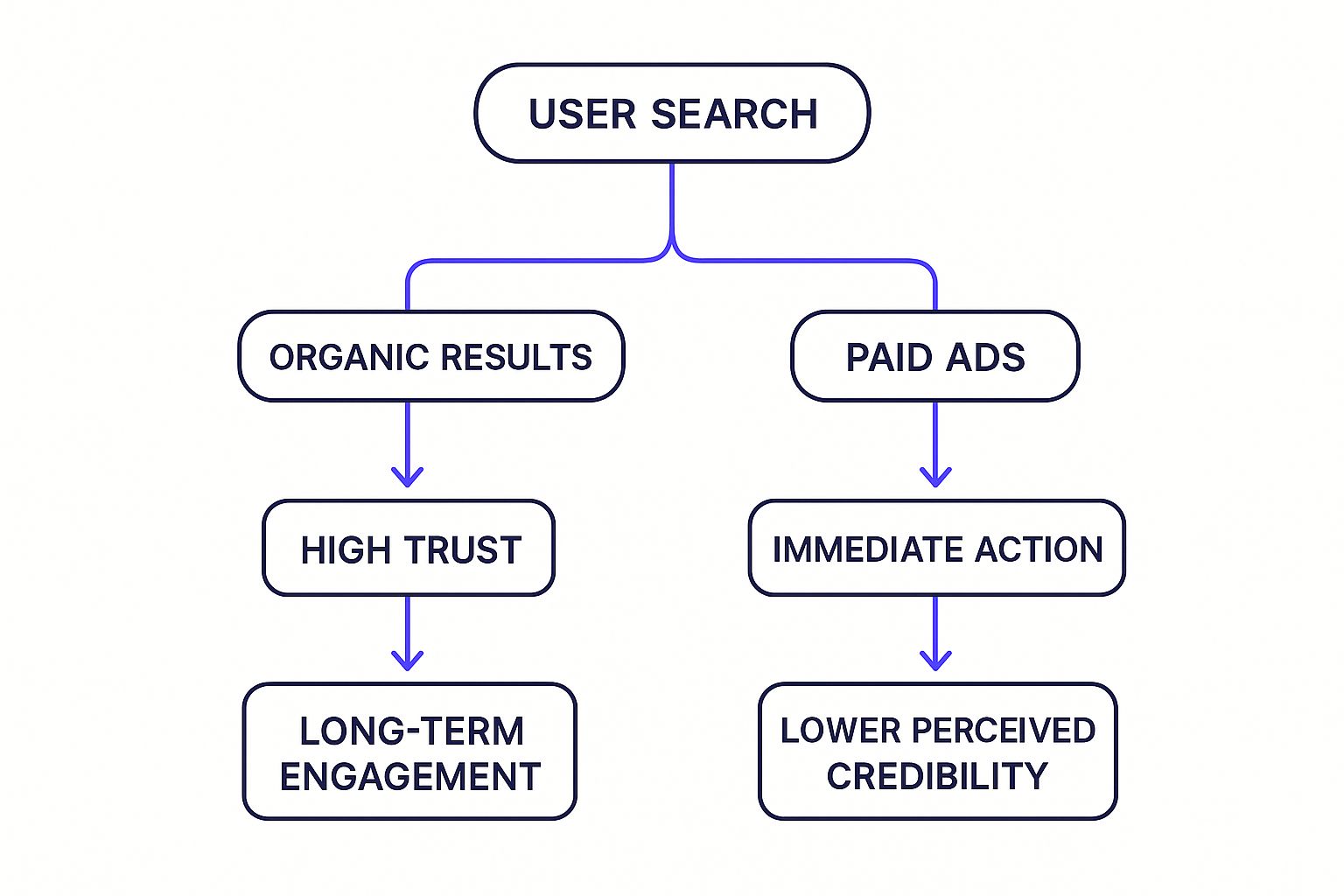
As you can see, organic search is tied directly to higher trust and long-term loyalty. Paid search, on the other hand, is the sprinter—built for immediate action, even if it carries a bit less inherent credibility.
Organic Search as an Authority Signal
Climbing to a top organic position instantly frames your brand as an industry leader. Users are smarter than ever and have developed a kind of "ad blindness," instinctively scrolling past the sponsored results to find what they consider the "real" answers. This built-in preference for earned media is a massive asset for long-term brand building.
The data backs this up in a big way. The #1 organic result on Google gets an average click-through rate (CTR) of 27.6%, while the top paid ad barely scrapes by with a 2.1% CTR. That staggering difference screams one thing: users place deep, instinctual trust in organic listings. You can dig into more of these fascinating user click-through-rate statistics to see the full story.
Building this kind of authority isn't just about writing great content. It's also about the off-page signals that prove to search engines your site is the real deal. If you want to understand how that works, our guide on what are backlinks is a great place to start.
Paid Search and Commercial Intent
Now, this doesn't mean paid ads are useless for building trust. While they don't have the same authoritative heft as organic results, a sharp, well-crafted ad from a brand people recognize can be incredibly effective—especially for users who are ready to buy right now.
When a user is ready to make a move, a relevant, clearly labeled ad isn't an annoying interruption—it's a shortcut. The trust factor here isn't about expertise; it's about brand reputation and how perfectly the offer meets the user's immediate need.
For example, someone searching "emergency plumber near me" isn't looking for a 2,000-word guide on pipe maintenance. They need a fast solution. In that moment, a top-ranking paid ad from a company with solid reviews delivers exactly what they're looking for. The trust is built on relevance and the promise of a quick fix.
Choosing the Right Channel for Your Business Goals
Look, the whole "organic vs. paid" debate is a distraction. The real question isn't "which one is better?"—it's "which one is right for what I need to do right now?" Picking a universal winner is a fool's errand. Each channel is a specialized tool, and the key is matching the job to the right tool.
Forget generic pro/con lists. It's time to start thinking in scenarios. You don't pick one side and stick with it forever; you pick the strategy that will get you the results you need, when you need them. This is how you make sure your money and effort actually move the needle.
Scenario 1: You're Launching Something New
When a new product or service drops, you have two urgent needs: speed and feedback. You can't afford to wait months for Google to notice you. You need to get in front of real, breathing customers today to see if your big idea has legs and to start making some money.
This is a job for paid search, no contest.
- Instant On: You can spin up a campaign and have targeted traffic hitting your landing page within hours. This lets you test everything—your messaging, your pricing, your audience—in real-time.
- Precision Targeting: You can get laser-focused on people actively searching for the exact solution you're offering. Every dollar of your initial ad spend goes toward reaching a high-intent audience.
Imagine an e-commerce store launching a new line of sustainable sneakers. With Google Ads, they can immediately pop up for anyone searching "eco-friendly running shoes," sending them straight to the new product page. No waiting, just immediate impact.
Scenario 2: You're Building Long-Term Brand Authority
For businesses built on expertise and trust—think B2B firms, specialized consultants, or high-end service providers—credibility is everything. The goal isn't just a quick sale; it's to become the undisputed go-to resource in your industry for years to come.
In this arena, organic search is the heavyweight champion.
By consistently publishing high-value, authoritative content that genuinely solves your audience's problems, you're not just ranking—you're building a powerful digital asset. Every top-ranking article or guide becomes a permanent billboard for your expertise, pulling in qualified leads long after you hit "publish."
This strategy is an absolute killer in the B2B world. Why? Because a staggering 71% of B2B buyers kick off their research with a generic search. They're looking for answers and solutions, not brand names. A strong organic presence is your ticket to getting in front of them right at the start of their journey. You can learn more about how B2B buyers think over at thinkwithgoogle.com.
Scenario 3: You're Pushing a Seasonal Sale or Promotion
When you’ve got a time-sensitive event like a Black Friday sale or a flash promotion, you need to make a lot of noise, fast. The goal is to hit both new prospects who are ready to buy now and existing customers you want to bring back.
This is the perfect moment for an integrated one-two punch using both channels.
Paid Search for the knockout blow: Run highly targeted ad campaigns screaming about the sale. Use ad copy with countdown timers—"Sale ends in 12 hours!"—to inject urgency and snag those high-intent searchers who are just looking for a deal.
Organic Search for the solid foundation: Your existing organic rankings for product categories will catch all the people doing broader research. A well-optimized site ensures you don’t miss out on this steady stream of traffic when the buying frenzy hits.
By deploying both, an online retailer can basically own the search results page. They capture the "buy-now" crowd with urgent ads while leveraging the hard-earned trust from their organic rankings to pull in the researchers. It's a win-win.
How to Integrate SEO and PPC for Maximum Impact
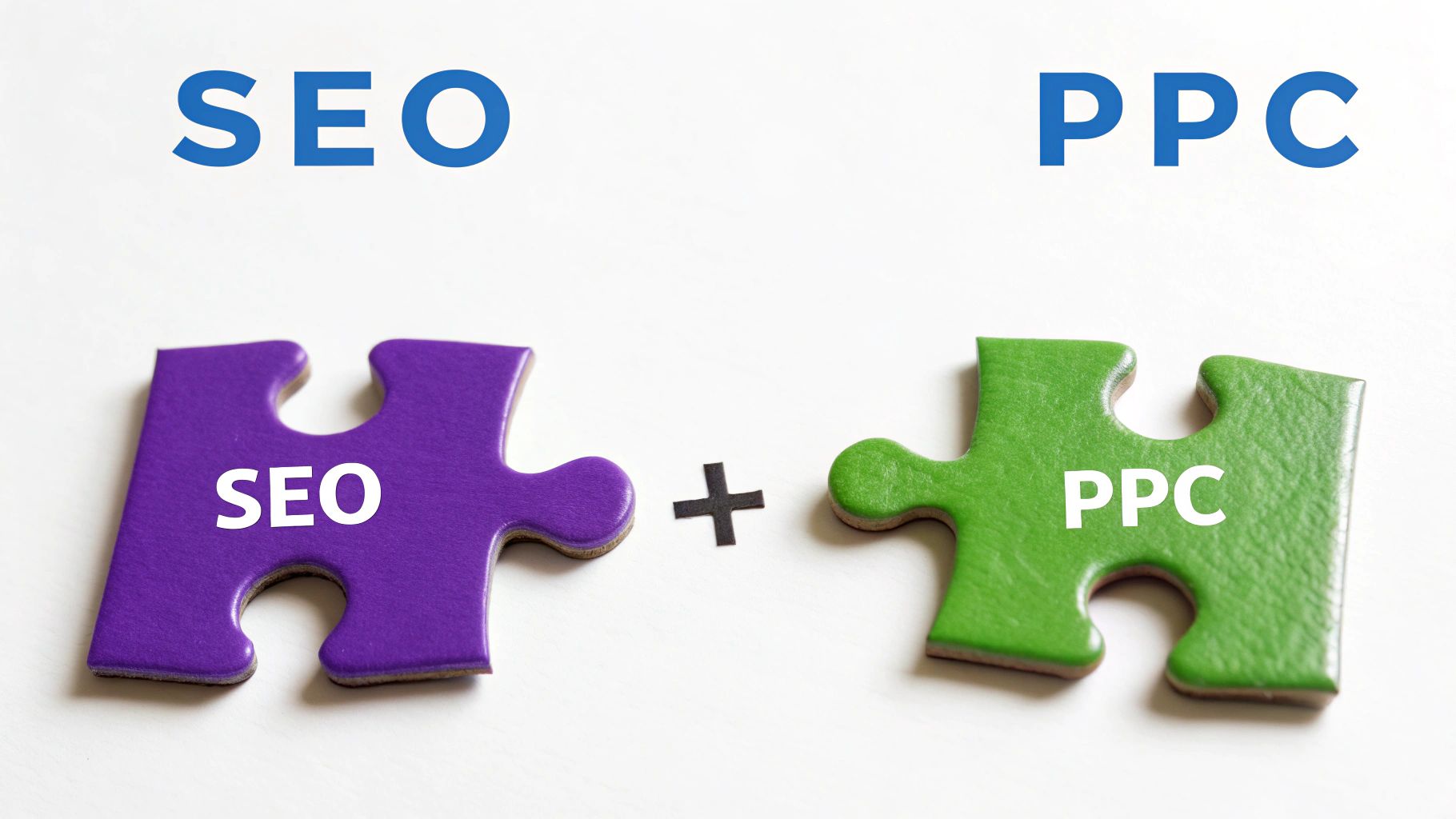
The smartest marketers know the organic vs. paid search debate is a false choice. The real question isn't which one to use, but how to make them work together. When you stop treating SEO and PPC as separate channels and start weaving them into a single, cohesive strategy, you get a force-multiplier effect that leaves competitors wondering what hit them.
It's about total SERP domination. Picture your brand owning both the top ad spot and the #1 organic result. That’s not just more visibility—it’s a powerful signal of authority that tells searchers you’re the definitive answer to their query.
Use PPC Data to Fuel SEO Wins
This is where the magic really starts. Your PPC campaigns are a goldmine of real-time, high-intent user data that can take months or years to uncover with SEO alone. Think of it as a cheat sheet for what your audience actually wants to buy.
Drill into your Google Ads reports. You’ll find high-converting, long-tail keywords your SEO team probably hasn't even considered. These are often hidden gems with lower competition and sky-high purchase intent. This data gives you a crystal-clear roadmap for what content to create, steering your organic efforts directly toward ROI.
To really dial this in, you need to be looking at the complete picture. This is where Search Engine Marketing Intelligence becomes mission-critical for making the right calls.
But remember, this is a two-way street. Once you identify keywords where you’re already crushing it organically (say, ranking in position 1 or 2), you can strategically pull back your PPC bids for those terms. That frees up your ad spend to go after more competitive keywords where your organic game is still catching up.
Create a Complete Funnel Experience
Here’s a classic scenario: a potential customer finds your brand through a fantastic, top-ranking blog post. They read it, love it, but then get distracted and leave without converting. With a siloed approach, that lead is gone.
This is where PPC comes in to save the day. By setting up a simple remarketing campaign, you can serve targeted ads to that exact user as they browse other sites or search again on Google. It’s a gentle, strategic nudge that reminds them of the value you offer and pulls them back to finish what they started.
This simple integration bridges the gap between that first organic discovery and the final conversion. You're not just running two separate campaigns; you're building a seamless customer journey that ensures no valuable lead ever slips through the cracks.
We Get These Questions All The Time
So, Can You Actually Do SEO for Free?
Not really, and anyone who tells you otherwise is selling something. While you don't pay Google for organic clicks like you do with ads, SEO is far from a free lunch. It demands a serious investment of time and brainpower.
You’re either paying with your own hours spent on keyword research, content creation, and technical fixes, or you're paying an expert to do it for you. Think of it as sweat equity versus checkbook marketing. There's always a cost.
How Long Until I See SEO Actually Working?
Paid search is like flipping a switch—traffic can start showing up within hours of launching a campaign. It's instant gratification.
Organic search, on the other hand, is the long game. It’s more like planting a tree than flipping a switch. You should expect to put in 3 to 6 months of consistent, focused work before you start seeing any meaningful traffic and rankings.
This is often the real decider between organic and paid search. Do you need leads right now to keep the lights on, or are you building a sustainable asset that will pay you back for years to come?
Ready to stop guessing and start growing? Rebus builds integrated search strategies that deliver real results. Let's put together your custom marketing plan.
